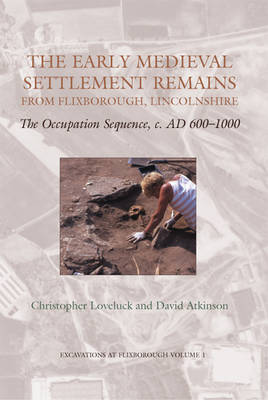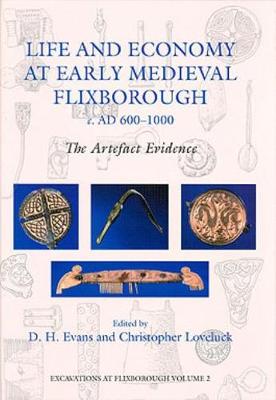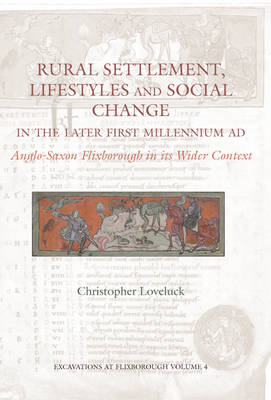Excavations at Flixborough
3 primary works
Book 1
The Early Medieval Settlement Remains from Flixborough, Lincolnshire
by Christopher Loveluck and David Atkinson
Published 12 November 2007
Between 1989 and 1991, excavations in the parish of Flixborough, North Lincolnshire, unearthed remains of an Anglo-Saxon settlement associated with one of the largest collections of artefacts and animal bones yet found on such a site. In an unprecedented occupation sequence from an Anglo-Saxon rural settlement, six main periods of occupation have been identified, dating from the seventh to the early eleventh centuries; with a further period of activity, between the twelfth and fifteenth centuries AD. The remains of approximately forty buildings and other structures were uncovered; and due to the survival of large refuse deposits, huge quantities of artefacts and faunal remains were encountered compared with most other rural settlements of the period. The quality of the overall archaeological data contained within the settlement sequence is important for both the examination of site-specific issues, and for the investigation of wider research themes and problems, facing settlement studies in England, between AD 600 and 1050. Volume 1 focuses on the occupation sequence, looking at the structural and stratigraphical evidence from the site, and interpreting the changing use of the site during its lengthy occupation. This interpretation of the occupation sequence forms the basis for all thematic discussions in Volumes 3 and 4. It also examines the evidence for burials at the site, and places this into the wider context of sepulchral practices in mid and late Saxon England. Finally there is discussion of the osteological remains themselves, giving hints of the demographic spectrum of the inhabitants, their lifestyles and ailments.
Book 2
Life and Economy at Early Medieval Flixborough, c. AD 600-1000
by D.H. Evans and Christopher Loveluck
Published 27 August 2009
Between 1989 and 1991, excavations in the parish of Flixborough, North Lincolnshire, unearthed remains of an Anglo-Saxon settlement associated with one of the largest collections of artefacts and animal bones yet found on such a site. In an unprecedented occupation sequence from an Anglo-Saxon rural settlement, six main periods of occupation have been identified, dating from the seventh to the early eleventh centuries; with a further period of activity, between the twelfth and fifteenth centuries AD. The remains of approximately forty buildings and other structures were uncovered; and due to the survival of large refuse deposits, huge quantities of artefacts and faunal remains were encountered compared with most other rural settlements of the period.
Volume 2 contains detailed presentation of some 10,000 recorded finds, over 6,000 sherds of pottery, and many other residues and bulk finds, illustrated with 213 blocks of figures and 67 plates, together with discussion of their significance.It presents the most comprehensive, and currently unique picture of daily life on a rural settlement of this period in eastern England, and is an assemblage of Europe wide significance to Anglo-Saxon and early medieval archaeologists.
Volume 2 contains detailed presentation of some 10,000 recorded finds, over 6,000 sherds of pottery, and many other residues and bulk finds, illustrated with 213 blocks of figures and 67 plates, together with discussion of their significance.It presents the most comprehensive, and currently unique picture of daily life on a rural settlement of this period in eastern England, and is an assemblage of Europe wide significance to Anglo-Saxon and early medieval archaeologists.
Book 4
Between 1989 and 1991, excavations in the parish of Flixborough, North Lincolnshire, unearthed remains of an Anglo-Saxon settlement associated with one of the largest collections of artefacts and animal bones yet found on such a site. In an unprecedented occupation sequence from an Anglo-Saxon rural settlement, six main periods of occupation have been identified, dating from the seventh to the early eleventh centuries; with a further period of activity, between the twelfth and fifteenth centuries AD. The remains of approximately forty buildings and other structures were uncovered; and due to the survival of large refuse deposits, huge quantities of artefacts and faunal remains were encountered compared with most other rural settlements of the period. The quality of the overall archaeological data contained within the settlement sequence is important for both the examination of site-specific issues, and for the investigation of wider research themes and problems, facing settlement studies in England, between AD 600 and 1050. Volume 4, offers a series of thematic analyses, integrating all the forms of evidence to reconstruct the lifestyles of the inhabitants. These comprise settlement-specific aspects and wider themes. The former include relations with the surrounding landscape and region, trade and exchange, and specialist artisan activity. Whereas the wider themes consider approaches to the interpretation of settlement character, the social spectrum of its inhabitants, changing relationships between rural and emerging urban centres, and the importance of the excavated remains within contemporary studies of early medieval settlement and society in western Europe.


